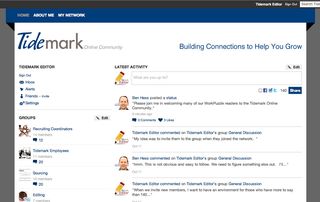Everyone has heard the saying "If it
were easy, everyone would do it." A couple of years ago, Ben wrote a
great piece on the difference between microwave and crock pot recruiting
that closely follows this principle.
Every tool and philosophy we espouse at
Tidemark is built upon this central principle. It is not surprising that 95% of
our clients hold to this principle as well. They have an underlying conviction
that in order to see results tomorrow, they must consistently engage in
systematic and seamless steps today. It's understood that
"microwave" recruiting will only obtain low hanging fruit that
competitors are also vying for. Conversely, "crock pot" recruiting
may take more time and discipline, but, over time, yields the higher caliber
and supplemental fruit that companies need in order to beat the
competition.
The differences in the conversations of a microwave
recruiter and the conversations of a crock pot recruiter resemble two
entirely different languages. A microwave recruiter typically offers anecdotal
excuses, usually with no statistics, regarding why they aren’t achieving their
goals. When asked a statistical question, the microwave recruiter will usually
give you an anecdotal answer. When asked how many candidates it takes to get
ten interviews…or how many interviews it takes to get each hire, a microwave
recruiter is usually unable to provide numbers. What do they provide instead?
More excuses. Why? Because a microwave recruiter does not track methods or
results.
What isn't measured cannot be managed,
predicted, or improved upon. However, recording and tracking results doesn’t
come naturally to most people. I often fall into the common trap of not
measuring what I do, or how I spend my time. And guess what? That’s invariably
when I’m not accomplishing much.
Now, don't get me wrong…there are always
factors that change percentages and numbers from one cycle to the next. There
is a time and place to dissect reasons and interpret the changes in percentages,
however, making excuses with no grounding in metrics is typically used as an
attempt to avoid accountability.
Discipline is the key to tracking and keeping
records. Disciplined people and organizations rarely offer excuses. They
implement systems to drive, track, and improve performance.
Discipline is
defined as:
1. Training expected to produce a specific
character or pattern of behavior.
2. Controlled behavior resulting from
training.
3. A set of rules or methods.
4. Activity, exercise, or a regimen that
develops or improves a skill.
5. Behavior in accord with rules of conduct;
behavior and order maintained by training and control.
6. A set or system of rules and regulations.
Two years ago, I wrote a four-part piece on an
expert recruiter (Andy Nazaroff) who clearly exercises discipline (1,2,3,4). He provides specifics regarding
calls, interviews, information, timing, conduct, etc… all of these methods
amount to consistent and impressive success.
For him and others like him, a belief system
is at the core of their success. They believe that discipline drives results,
and increases responsibility — two characteristics of every successful
company.
Let me know your thoughts and your own methods
for assuring your own discipline.
 Editor's Note: This article was written by Dr. David Mashburn. Dave is a Clinical and Consulting Psychologist, a Partner at Tidemark, Inc. and a regular contributor to WorkPuzzle. Comments or questions are welcome. If you're an email subscriber, reply to this WorkPuzzle email. If you read the blog directly from the web, you can click the "comments" link below.
Editor's Note: This article was written by Dr. David Mashburn. Dave is a Clinical and Consulting Psychologist, a Partner at Tidemark, Inc. and a regular contributor to WorkPuzzle. Comments or questions are welcome. If you're an email subscriber, reply to this WorkPuzzle email. If you read the blog directly from the web, you can click the "comments" link below.












